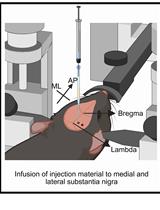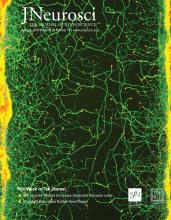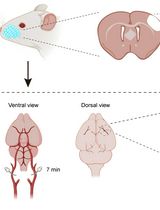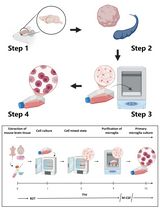- EN - English
- CN - 中文
Cylinder Test to Assess Sensory-motor Function in a Mouse Model of Parkinson’s Disease
基于圆筒试验的小鼠帕金森综合症模型中感觉运动系统功能测试
发布: 2019年08月20日第9卷第16期 DOI: 10.21769/BioProtoc.3337 浏览次数: 13260
评审: Miao HeTsvetan SerchovGeoffrey C. Y. Lau

相关实验方案

基于 rAAV-α-Syn 与 α-Syn 预成纤维共同构建的帕金森病一体化小鼠模型
Santhosh Kumar Subramanya [...] Poonam Thakur
2025年12月05日 1388 阅读
Abstract
Parkinson’s disease is a progressive neurodegenerative movement disorder that happens due to the loss of dopaminergic neurons in the substantia nigra. The deficiency of dopamine in the basal nuclei drives cardinal motor symptoms such as bradykinesia and hypokinesia. The current protocol describes the cylinder test, which is a relatively simple behavioral assessment that evaluates the motor deficits upon unilateral degeneration of the nigrostriatal pathway in experimental models of Parkinson’s disease. Since dopamine-depleted mice exhibit the preferential use of the forelimb ipsilateral to the lesion, here researchers perform the cylinder test to investigate the therapeutic effects of antiparkinsonian treatments on the performance of the contralateral (injured) limb.
Keywords: Cylinder test (圆筒实验)Background
The cylinder test measures the rodent's spontaneous forelimb use, which can be used to evaluate the sensory-motor function in a number of injury models that cause forelimb use asymmetry (Schallert et al., 2000). In this test, the mouse is placed in a glass cylinder and the number of times it rears up and touches the cylinder wall is measured. The wall touches are subsequently scored for the left, right, or both paws by an observer in slow motion recorded videos. The results are expressed as the percentage of each paw usage relative to the total number of touches.
The cylinder test is a common behavioral assessment used to evaluate the motor impairments in experimental models of Parkinson’s disease. Our laboratory and others have previously shown that mice with unilateral injection of 6-OHDA in the striatum, substantia nigra pars compacta or medial forebrain bundle exhibit a remarkable forelimb asymmetry due to lesion of the nigrostriatal pathway (Iancu et al., 2005; Kriks et al., 2011; Subramaniam et al., 2011; Boix et al., 2015; Chu et al., 2017; Magno et al., 2019). While a healthy mouse uses the right and the left paw indifferently, dopamine-lesioned mice show preferential use of the paw ipsilateral to the lesion (Figure 1).
The cylinder test can be used to evaluate the preclinical screening of antiparkinsonian therapeutic interventions based on the functional recovery of the contralateral paw (Kriks et al., 2011; Francardo et al., 2014; Fischer et al., 2017; Magno et al., 2019). A number of other unilateral experimental models of neurological disorder including spinal cord injury and cerebral ischemia have been shown to be sensitive to the degree of forelimb asymmetry measured in the cylinder test (Schallert et al., 2000; Starkey et al., 2005; Venna et al., 2014; Wang et al., 2015; Warren et al., 2018; Carballo-Carbajal et al., 2019).
The cylinder test has been found to be easy to perform and sensitive to detect motor impairments that other behavioral tests fail to detect. On the other hand, analysis of the videotape records are time-consuming, and the test cannot be repeated frequently as mice will lose interest in exploring the vertical surface of the cylinder (Lundblad et al., 2002).

Figure 1. Parkinson's disease mouse model in the Cylinder Test. The contralateral paw is located in the opposite side of the 6-OHDA unilateral injection. For example, the left paw is considered contralateral when 6-OHDA is injected in the right brain hemisphere. Unilateral lesion of the striatum with 6-OHDA causes preferential use of the forelimb ipsilateral paw (the paw in the same side of the lesion).
Materials and Reagents
- Black curtain
- Mice
- Ethanol 70% (Ciclo Pharma, supplied by Prime Cirúrgica, catalog number: 67)
- Soap (Ciclo Pharma, supplied by Prime Cirúrgica, catalog number: 61)
Equipment
- Glass cylinder 20 cm in diameter and approximately 40 cm in height
In our lab, we use a 2 L graduated beaker made of borosilicate glass (Global Glass, catalog number: GTBFB-2000). - Three digital cameras capable to record videos at 15-25 frames per second, 1,280 x 720 pixels of resolution, and fulfilled with built-in infra-red (IR) illumination and onboard storage (TP-link, catalog number: NC250)
- Timer (Fisher Scientific, Traceable Nano, catalog number: 14-649-83)
- Any computer or TV capable of running the recorded video files
Software
- Any media player with video support and capability to change the playback speed. In our lab, we use the VLC Media Player v3.0.6 (VideoLAN, http://www.videolan.org/vlc/)
- GraphPad Prism (GraphPad Software, http://www.graphpad.com)
Procedure
文章信息
版权信息
© 2019 The Authors; exclusive licensee Bio-protocol LLC.
如何引用
Readers should cite both the Bio-protocol article and the original research article where this protocol was used:
- Magno, L. A. V., Collodetti, M., Tenza-Ferrer, H. and Romano-Silva, M. A. (2019). Cylinder Test to Assess Sensory-motor Function in a Mouse Model of Parkinson’s Disease. Bio-protocol 9(16): e3337. DOI: 10.21769/BioProtoc.3337.
- Magno, L. A. V., Tenza-Ferrer, H., Collodetti, M., Aguiar, M. F. G., Rodrigues, A. P. C., da Silva, R. S., Silva, J. D. P., Nicolau, N. F., Rosa, D. V. F., Birbrair, A., Miranda, D. M. and Romano-Silva, M. A. (2019). Optogenetic stimulation of the M2 cortex reverts motor dysfunction in a mouse model of Parkinson's disease. J Neurosci 39(17): 3234-3248.
分类
神经科学 > 感觉和运动系统 > 动物模型
神经科学 > 神经系统疾病 > 帕金森氏症
您对这篇实验方法有问题吗?
在此处发布您的问题,我们将邀请本文作者来回答。同时,我们会将您的问题发布到Bio-protocol Exchange,以便寻求社区成员的帮助。
Share
Bluesky
X
Copy link











